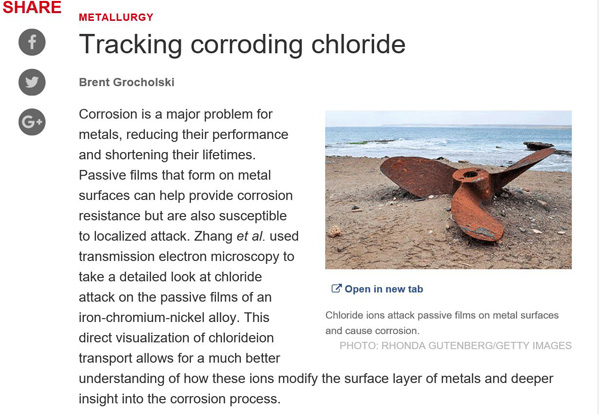The scientists at Institute of Metal Research, Chinese Academy of Sciences (IMR, CAS) recently unmask chloride attack on the passive film of metals, which is one of the most important problems in corrosion science. Nature Communications published this work online. Science highlighted this work via editor’s choice and concludes that “This direct visualization of chloride ion transport allows for a much better understanding of how these ions modify the surface layer of metals and deeper insight into the corrosion process”. This work was performed by a research team with leading scientists of Prof. MA Xiuliang, Dr. ZHANG Bo and Dr. WANG Jing at the Solids Atomic Imaging Division of IMR.
Nanometer-thick passive films on metals usually impart remarkable resistance to general corrosion but are susceptible to localized attack in certain aggressive media, leading to material failure with pronounced adverse economic and safety consequences. Over the past decades, several classic theories have been proposed and accepted, based on hypotheses and theoretical models, and oftentimes, not sufficiently nor directly corroborated by experimental evidence.
The Solid Atomic Imaging Division at IMR has a long-standing tradition with several decades of applying transmission electron microscopy to materials science. They use aberration-corrected transmission electron microscopy to directly capture the chloride ion accumulation at the metal/film interface, lattice expansion on the metal side, undulations at the interface and structural inhomogeneity on the film side, most of which had previously been rejected by existing models. This work unmasks, at the atomic-scale, the mechanism of chloride-induced passivity breakdown which is known to occur in various metallic materials.

Fig. 1 Interface between the nanocrystals and the amorphous zone provides a favorable channel for chloride ion diffusion. (a) HRTEM images along the [001] axis of the austenitic matrix showing that the passive film is mainly amorphous with some nano-crystals. (b) HRTEM images along [001] axis showing three fine crystals within the passive film. (c) Energy barriers to Cl- ion diffusion from one oxygen vacancy to a neighboring one in the three zones. (Image by IMR)

Science Editor’s Choice (Science 361, 989)